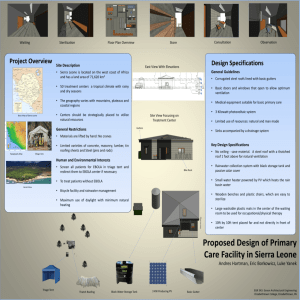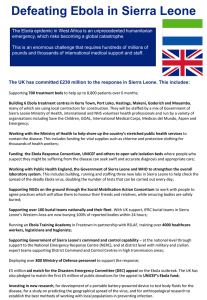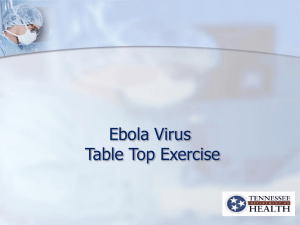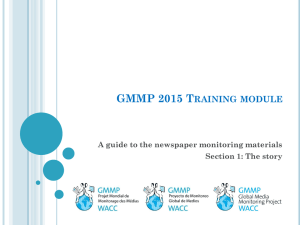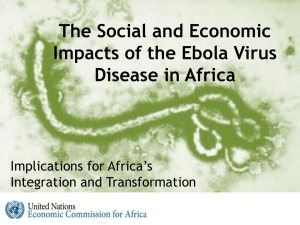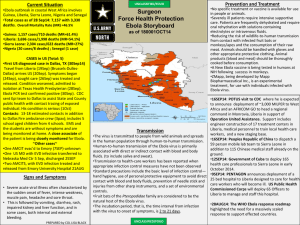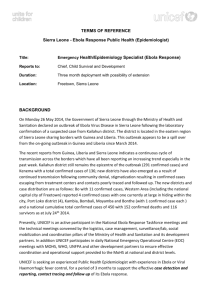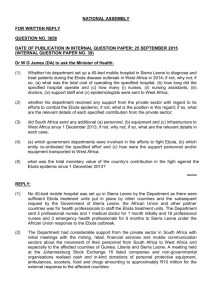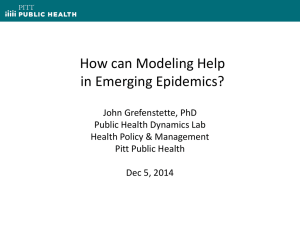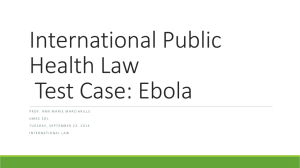Cordaid External Verification PBF Health Sector Sierra Leone
advertisement
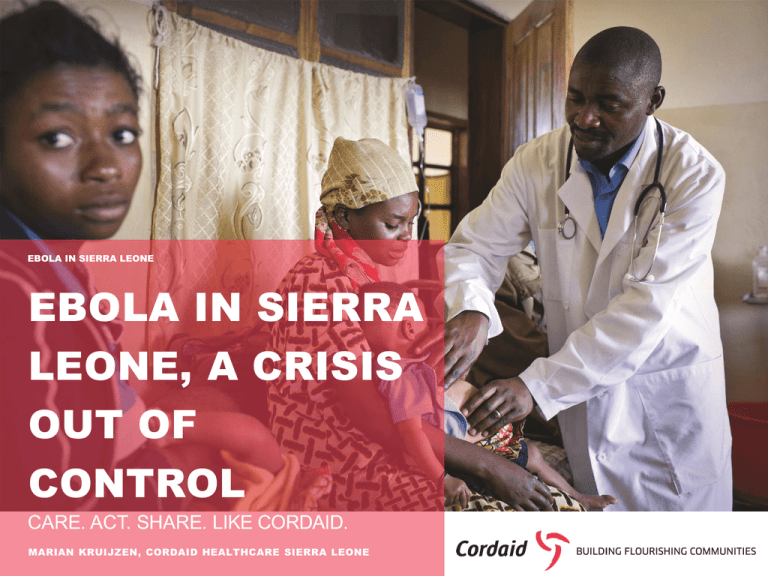
EBOLA IN SIERRA LEONE EBOLA IN SIERRA LEONE, A CRISIS OUT OF CONTROL CARE. ACT. SHARE. LIKE CORDAID. MARIAN KRUIJZEN, CORDAID HEALTHCARE SIERRA LEONE OVERVIEW OF THE PRESENTATION Ebola in Sierra Leone, a crisis out of control 1. Causes of the Ebola crisis being out of control 2. Current situation 3. Cordaid response 4. Needs short, mid, long term Ranking on Human Development Index of 187 countries: Sierra Leone, 183; Guinea 179; Liberia 175 1: CAUSES OF THE EBOLA CRISIS BEING OUT OF CONTROL Two main causes: 1. Weak/Young health system • Centralised management, decentralised only on paper • Mostly vertical inputs, young PBF scheme • HRH capacity insufficient and low • Lack of infrastructure, communication, transport, drugs ,laboratoty, equipment at facilities • Inmature HMIS and DHIS • No ‘early warning’ or ‘epidemic response system’ 2. Social and cultural factors • Lack of health information and community involvement, traditional healers • Distrust towards officials, politicizing • Cultural believes, habits • Poverty and bushmeat consumption 2: CURRENT SITUATION Still delayed international response and coordination challenges. Little involvement local NGO’s 1. Health system • • • • • 2. Health system collapsed, abandoned health facilities; increased mortality preventable conditions Demotivated HWs, not paid in time, ill-equipped, not fully trained, victims themselves and stigmatised in society. No protective gear and materials in most health facilities Huge transport and logistic challenges Social and cultural • SL: Confirmed cases 3100; confirmed deaths 960; people quarantined 17000; WHO: real figures 2-3 times higher. 22% children < 18 yrs • travel restriction to any district and neighboring countries; • All schools closed; no gatherings • Distrust and denial • Stigma and food shortage patients and families • Economic decline UNMEER targets of 1 October: “70-70-60 plan” : 70% safe burials; 70% hospital-based isolation of suspected cases within 60 days. by 1 December, the detection of new Ebola cases could rise up to 10,000 per week. QUARANTINED FAMILY IN BOMBALI 3: CORDAID RESPONSE Goal: Emergency response; Prevention; Recovery health services; Inclusion community health committees; Restore public confidence in the healthsystem 1. 2. 3. 4. 5. 6. Consortium project: Community prevention, sensitization, response: 15/8-15/11 by 3 healthcare partners (HPA-SL, PPA-SL and CB) in 3 Districts (Kenema, Bombali, Pujehun). Total amount € 220.000. Total population 450.000 and 117 health facilities. 5 small grants: Lunsar hospital and 4 NGO’s (radio messages, awareness, materials, door-to-door sensitization) Mainstream Ebola prevention in 6 food security programs. Shipment of 46 pallets with Ebola screening kits for 11 faith-based hospitals and 24 clinics. Challenges on procurement and transport. Development and production Ebola Memory Game ‘STOP Ebola’ with the Dutch Web Foundation and local partners Discussion with MoHS PBF-team on ebola indicators In preparation: 1. Upscaling and expansion current and new initiatives 2. Two Cordaid staff to Sierra Leone for management, coordination and advise 4. NEEDS SHORT-TERM UNTIL OUTBREAK IS UNDER CONTROL 1. Focus on health system: • • • • Vaccines and medicine Emergency input HRH, holding and treatment centers, diagnostic capacity, protective gear and materials, ambulances/cars, etc, (air freight logistics) Health System Strenghtening: Ebola indicators; HW’s motivation package; inclusion community Set up early warning system 2. Social and cultural involvement • • • • • Prioritize community involvement and capacitate Village Health Team (VHT) and community health workers Continued health education, focus on ‘community change agents’ like TBA’s and traditional healers Burial teams (training, logistics) Dietary needs of discharged patients Psycho-social support and stigma/discrimination control Note: challenges at (inter)national coordination and response level should be dealt with by Governments and UN-bodies. 4: NEEDS MID- AND LONG-TERM Mid term • Move from input to Output/Performance Based Funding. Incorporate infection control indicators • Technical Assistance to recover and strengthen the health system • Build a well-coordinated response system operating at several levels but starting at the Village Health Teams (VHT) and community health workers (Uganda case). • Focus on rural areas with health education • Food security (no more bush meat!) • Restore entrepreneurship and Investments Long term Build resilient health systems and societies!
